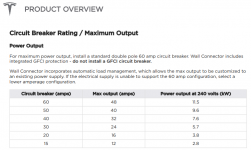nietzj
Senior Member
- Location
- St. Paul, Minnesota
- Occupation
- Electrician
I’m planning to install a Tesla wall Charger and just wanted to double check my thoughts. The main is 125a and this charger can draw up to 48a continuously for well over 3 hours. If the main should trip at around 100a that’s a bit concerning when adding this size of a load. I plan to use #6 THHN for the current carrying conductors and a #10 for the ground. This will be in a 3/4” pvc so I know I’m fine landing this on a 60a breaker. Regardless, I never intend to charge at the full 48a out of fear of straining every connection throughout the system. I understand when setting up the app you can select the breaker size so a guy could just input this as a 50a or even a 40a breaker causing the charger to reduce the current. My question is for those who have installed/programmed these chargers should I use a 60a, 50a or even a 40a breaker?
I did ask a similar question last week, sorry for the redundancy, don’t want to screw this up.
I did ask a similar question last week, sorry for the redundancy, don’t want to screw this up.



